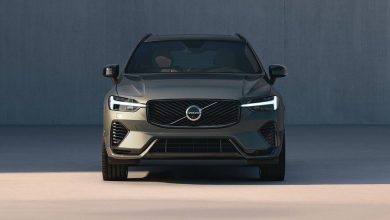Bugatti’s Mistral Is Their Swan Song For Its Quad-Turbo W16
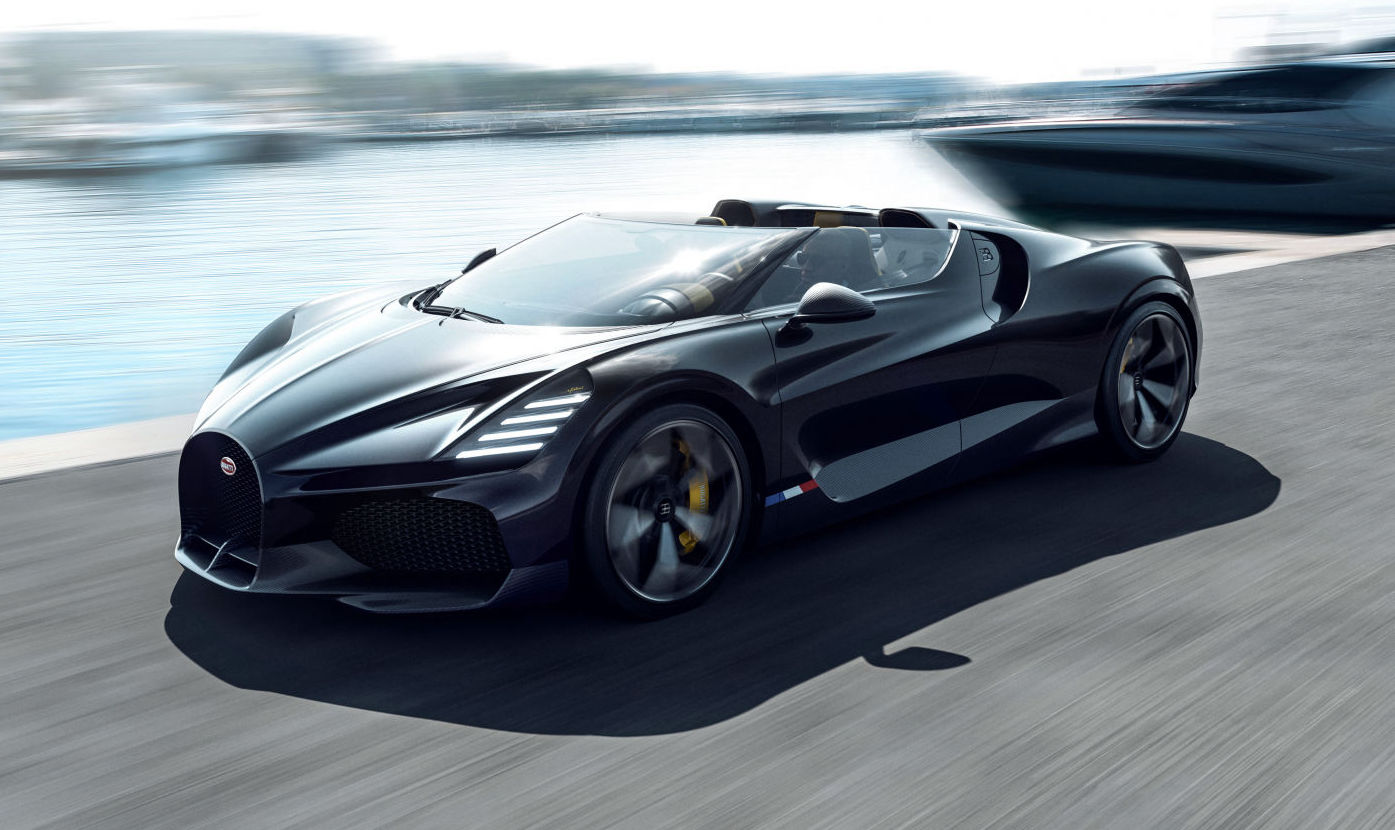
The Bugatti W16 is being sent off in style with a limited-run €5 million hyper-cabriolet.
With Chiron production of already coming to an end, Bugatti is therefore also soon to be closing the chapter on its legendary quad-turbocharged 8.0-litre W16 engine. A beast of a power plant that roared its way into the top-speed record books with the Veyron back in the early naughties, the days of this Goliath is unfortunately numbered as the hypercar manufacturer moves on into the future under the custodianship of Rimac.
But with Bugatti being Bugatti, the end of its W16 era has to be marked with something truly spectacular. And the recently revealed W16 Mistral certainly fits the bill, serving as a rather swanky swan song to what is undoubtably one of the best internal combustion engines to ever be produced.
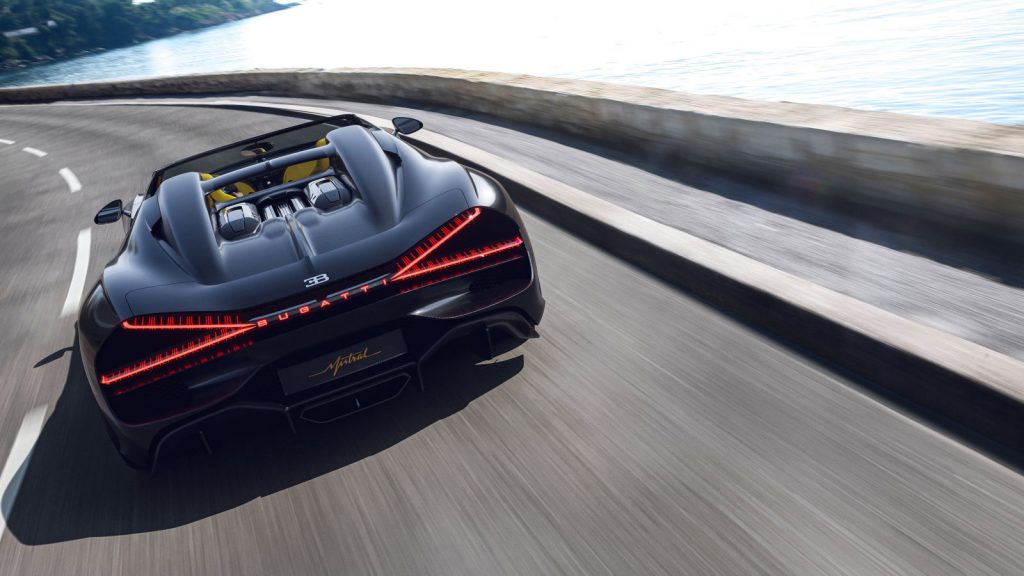
The first roadster in what Bugatti dubs the Chiron era and the first drop top from the marque since the Veyron Grand Sport Vitesse that ended production back in 2015, the W16 Mistral takes its name from a powerful wind that blows from the Rhône River valley through to the Mediterranean. A name that is rather fitting, as the Molsheim marque has already stated its goal with this hyper-cabriolet is to reclaim the drop-top top-speed crown back from Hennessey, where its Venom GT Spyder is currently the record-holder at 413 km/h.
Packing the same 8.0-litre quad-turbo W16 as the Chiron Super Sport 300+, the W16 Mistral with its 1,600 PS and 1,600 Nm of torque would certainly live up to Bugatti’s claim of it offering ‘performance unlike any open top car that has gone before’. Though thanks to a truly stunning design too, this hyper-cabriolet does look like its travelling a million miles an hour even when sitting completely still.
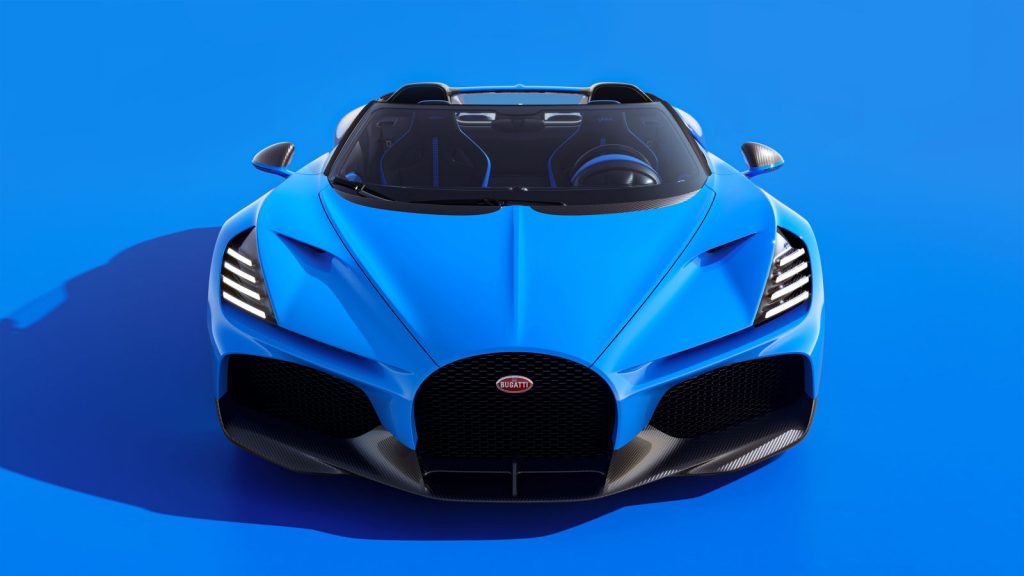
The vertically-stacked LED strips that make up the front headlight assembly are perhaps primarily responsible for this super-speed-while-standing-still appearance, though the Bolide-inspired X-shaped rear light bar might probably just be the cooler lighting feature on the W16 Mistral. Other standout design details with this drop-top meanwhile are an aggressively curved V-shaped windscreen that apparently wrap around the cockpit like a helmet visor, and a pair of new roof-mounted air intakes that Bugatti touts to be inspired from the 1934 Type 57 Roadster Grand Raid.

Bugatti has also delved further into history by incorporating a wood and an amber insert containing a sculpture of Rembrandt Bugatti’s ‘dancing elephant’ into its aluminium-machined gear lever. That and some new woven-leather door panels (as well as of course the distinct lack of carbon fibre above where the occupants sit) is about the sum changes that has been made within the W16 from its Chiron counterpart.

Targeted to arrive in 2024, buyers interested in the W16 Mistral will be looking to fork out a cool €5 million (RM 25 million) for the privilege of owning one of these uber-exclusive hyper-convertibles. Those however who are just getting their cheque books out now after reading are unfortunately already way too late, as all 99 allocations have already been spoken for before it was even unveiled to the public.

PRESS RELEASE: Ever since the Veyron was introduced in 2005, the W16 engine has been the beating heart of every Bugatti. The roadgoing car that brings the W16 era to an end was always destined to be special: exclusive, elegant and powerful. It must be the very best of its kind. This is W16 Mistral: the ultimate roadster.
Mate Rimac, Bugatti Rimac CEO, said: “For the final roadgoing appearance of Bugatti’s legendary W16 engine, we knew we had to create a roadster. Well over 40% of all Bugatti vehicles ever created have been open-top in design, establishing a long lineage of performance icons that – to this day – are revered the world over. In the Chiron era there had, to-date, been no roadster, so the introduction of W16 Mistral continues this legacy, driven by enormous demand from our clients for an all-new way to experience the mighty performance of our iconic engine. The W16 Mistral opens the next chapter in the Bugatti roadster story, inspired by over a century of open top legends.”
For a car as evocative and important as this, great consideration went into the badge it should wear. Far more than simply a development of the Chiron, the roadster needed a name associated with freedom, elegance and speed. Inspiration came from the mistral, a powerful wind that blows from the Rhône River valley, through the chic towns of the Côte d’Azur in southern France and into the Mediterranean. And with the engine so central to this roadster’s character, it stands side-by-side with this mighty wind: W16 Mistral.
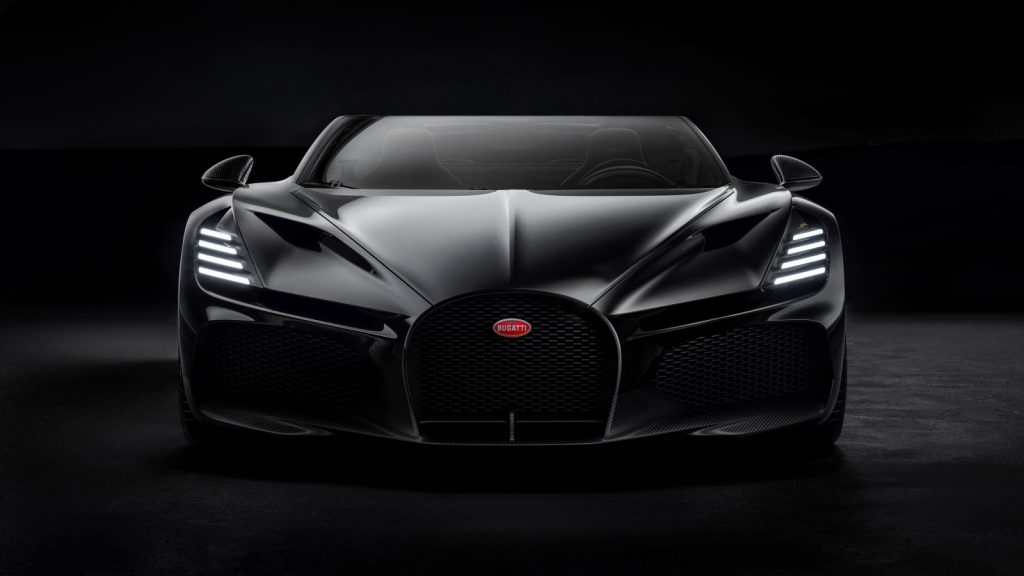
Built around the definitive 1,600 PS incarnation of the W16 engine, first used in the Chiron Super Sport 300+, the W16 Mistral offers performance unlike any open top car that has gone before. In its design and engineering it is completely bespoke; the existing monocoque is not simply cut off above the A-pillars to make way for the new open-top design but has been reengineered and reshaped to create a more rounded silhouette without compromising performance.
Their muse would be the 1934 Bugatti Type 57 Roadster Grand Raid, a sporting roadster that represents the pinnacle of elegant design. Marked out by its dual aerodynamic headrests, flowing backwards into the bodywork, and a cut down V-shaped windscreen, this particular Grand Raid – on display at the Louwman Museum in Den Haag – is effortlessly sophisticated with an understated sportiness. Finished in a duo-tone black and yellow livery, it would provide the perfect inspiration for this watershed moment in the Bugatti story.
The W16 Mistral debuts in colors inspired by the Bugatti Type 57 Roadster Grand Raid; a warm black with hints of truffle brown and subtle yellow accents throughout. Not only is it an homage to the iconic coachbuilt body, but also to Ettore Bugatti, who chose the black and yellow combination for many of his personal cars, including his Type 41 Royale. To enthusiasts of the brand, it is a timeless visual pairing.
The W16 Mistral captures the essence of the Grand Raid’s V-shaped windscreen and evolves it into a modern-day work of art. A curving windscreen that seemingly wraps around the A-pillars, blending seamlessly into the side windows and creating a ‘visor’ effect that hints at the motorsport levels of performance W16 Mistral offers. The windscreen itself is a marvel of engineering, curved just enough to create the rounded visor design, without distorting the driver’s vision.
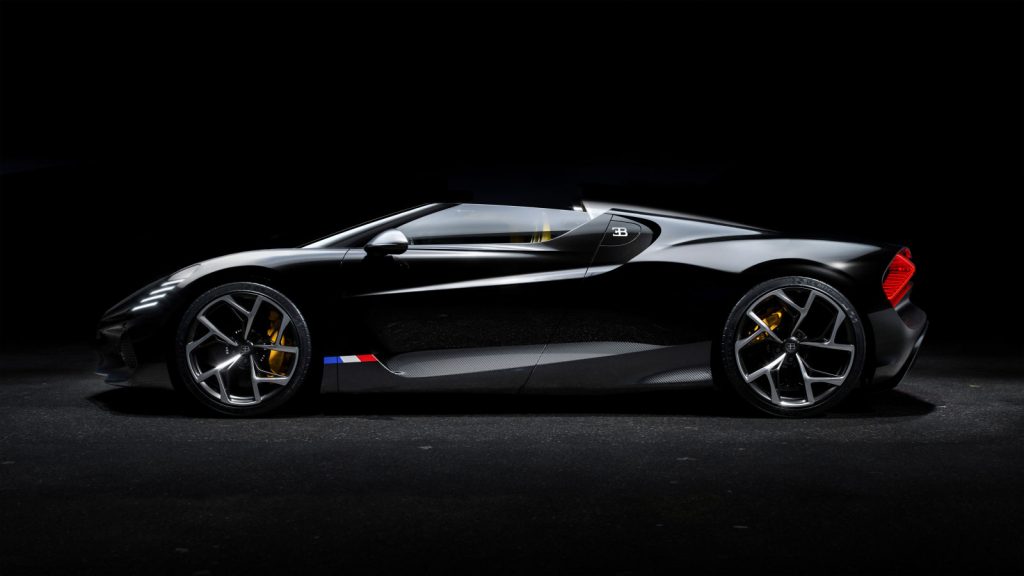
The top line of the windscreen and side windows flows purposefully around the side air intakes. This character line then flows back underneath the side glass to shoot through all the way to the front horseshoe grill creating a new three-dimensional character for the famous Bugatti C-line introduced on Chiron. To keep the body side section slim, but also allow for optimum airflow to the W16, the oil cooler intakes on the side were deliberately separated from the engine air intakes, which now sit on the roof, just behind the occupants. The two-new roof-mounted engine air scoops are a nod to the Type 57 Roadster Grand Raid, as well as the first open top Bugatti of the modern era: the Veyron 16.4 Grand Sport. Tighter, more powerful and appearing to leap forwards, W16 Mistral exhibits an entirely different character.
To design a car like the W16 Mistral requires careful practice of Bugatti’s ‘Form Follows Performance’ design mantra, with each component penned not just to set new standards for beauty, but to also play a role in achieving completely new levels of performance.
But the functional design highlights don’t end there. The new ram induction air scoops behind the headrests were developed from the very beginning with stringent rollover tests in mind, so each is made from a bespoke carbon fiber structure that can support the whole weight of the car in case of a roll over. This new intake layout also enriches the driver’s W16 experience, emphasizing the orchestra between the low down, mighty, rumbling 8-liter displacement intake noise at throttle on and the blow off valve whistle from the four turbo chargers at throttle lift. It is an unmatched aural sensation in the automotive world.
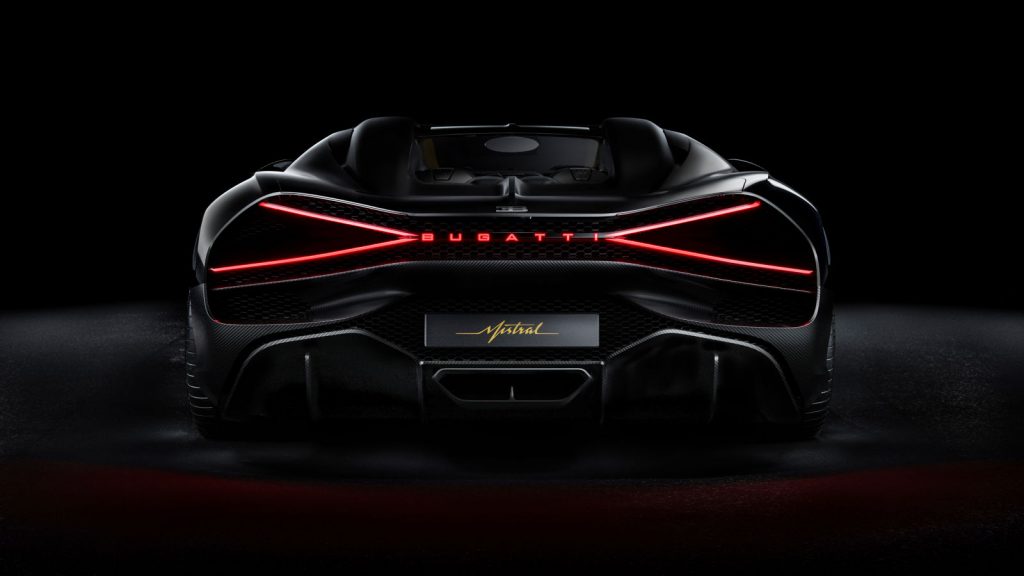
To develop incomparable levels of elegance and excitement, the W16 Mistral features the very latest engineering innovations. Bugatti’s advanced composite materials are paired with cutting-edge titanium and aluminum 3D-printing to ensure striking design, ultimate performance and robust reliability. A detailed analysis of the W16 Mistral’s dynamic stiffness allowed engineers to develop lightweight solutions that would ensure optimum handling and performance under the most extreme conditions.
The W16 Mistral’s interior takes its lead from Chiron, carefully honed to deliver an experience that’s both elegant and luxurious, but also functional enough to ensure all information is easily visible at up to 420 km/h. The dedication to material quality remains a hallmark of Bugatti design; advanced, lightweight titanium, aluminum components milled from a solid block and soft, blemish-free leathers. But in this swansong to the W16, there are also brand new design flourishes.
There is an intricate woven leather used on newly designed door panels, meticulously tested and produced to Bugatti quality standards with a vision of regular use over a hundred years into the future. And in a nod to the W16 Mistral’s illustrious forebears, the gear shifter – machined from a solid block of aluminum – features a touch of wood and an amber insert with Rembrandt Bugatti’s famous ‘dancing elephant’ sculpture locked within. Iterations of this sculpture adorned the bonnet of the legendary Type 41 Royale; the most luxurious roadster ever created.
Underneath the gargantuan side opening hood of the Royale was an ambitious 12.7-liter straight-eight engine, the likes of which the world had never seen before. And the W16 Mistral’s engine is equally ambitious – the only W16 powertrain in automotive use today.
When Bugatti’s last roadster, the Veyron 16.4 Grand Sport Vitesse set a world speed record of 254.04 mph (408.84 km/h) in 2013, its 8.0-liter quad-turbo W16 had 1,200 PS. The W16 Mistral has 1,600 PS, making use of the same power unit that propelled the Chiron Super Sport 300+ to a world-record-breaking speed of 304.773 mph in 2019. There can only be one goal in mind: to become the fastest roadster in the world once more.
Only 99 examples of the W16 Mistral will be built, priced at 5 million euros net, with deliveries due to begin in 2024. The entire production run of W16 Mistral is already sold out.


